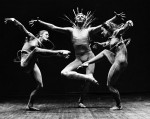Column Name
Title
Former dance faculty member Ruth Miller Currier, who was the director of the José Limón Dance Company after Limón’s death, died on October 4 in Brooklyn at 85. She was long divorced and no members of her immediate family survive her. Born January 4, 1926, in Ashland, Ohio, Currier studied at Black Mountain College in North Carolina and Washington Square College, as the undergraduate branch of N.Y.U. was known until the 1970s. Among her teachers were José Limón, for whom she became a principal dancer in 1949, and Doris Humphrey. After Juilliard’s Dance Division opened, in 1951, Currier joined Limón and Humphrey on the faculty from 1953 to 1958. One highlight of her choreographic career was when Humphrey, who was dying of stomach cancer and hadn’t completed her Bach Brandenburg Concerto No. 4, asked Currier to finish it. The completed work was premiered at Juilliard, to great acclaim, at a posthumous benefit for Humphrey in 1959. Even after founding her eponymous company, in 1958, Currier continued to dance with Limón, creating roles in classic works including Night Spell, There Is a Time, and Missa Brevis. When Limón died, in 1972, Currier was made the director of his company, which, according to The New York Times, became the first major modern dance company to survive the death of its founder. In addition to Juilliard, Currier taught at Bennington, Sarah Lawrence, and at the American Dance Festival. Martha Gallagher Wittman (Diploma ’58, dance), who worked closely with Currier for 10 years in the 1950s and 1960s, remembers the dancer. (For more about Wittman, see “Six Dancers Reminisce.”)
Body
I first met Ruth Currier in the mid-1950s while I was a member of the Juilliard Dance Theater company, which had just been formed by faculty member Doris Humphrey. Ruth was Doris’s rehearsal assistant, but she was also so much more than that title implies. Because of Doris’s disability [crippling arthritis], Ruth became the physical translator of Doris’s creative visions. Many ideas were first tried out on Ruth’s body, then taught to us at a later time.
I then became a member of Ruth’s own company and also served as teaching assistant for her composition and repertory classes over the summers of 1960 and 1961. This was a tremendous learning ground for both me and all of Ruth’s students. She was a dedicated teacher and brought clarity, support, respect, humor, and high expectations into all of her classes. She also often brought examples from other arts—music, literature—into her classes to make assignments more clear. One has always stayed with me: a fragment from James Agee’s 1957 Pulitzer Prize-winning novel A Death in the Family that read, “but will not, oh, will not, not now, not ever; but will not ever tell me who I am,” which she read as an example of constructing a repetition, but of course it also introduced us to Agee’s writing—and who could stop at that little sample? Ruth’s beloved cats, Belle and Gypsy, also sometimes showed up as examples of, as I recall, “successional symmetry,” as they sat spiraled around each other in identical shapes.
Ruth had strong feelings about dance and about principles she felt should not be ignored and that she thought should be passed along to others. But she was also delighted by surprises such as seeing creative work take an unexpected turn or a fresh solution found.
Ruth was responsible for bringing me and my husband, musician/composer Josef Wittman, to Bennington College, where we ended up teaching until 1994. She believed the Bennington dance division needed a musician on the faculty who was experienced in working with dance (Josef had previously been, among other jobs, an accompanist at Juilliard). Music was of great importance to Ruth—she had been a pianist before she was a dancer—and she felt that a resident musician was an invaluable resource for a dance department.
I sometimes rode with Ruth between Bennington and New York City when we needed to rehearse in both places. Once underway, the cats were free to leave their carrier, and one of them, I forget which, sometimes liked to sit on her lap with its paws on the steering wheel.
Ruth was a gorgeous, riveting performer and the 10 years or so over which our lives connected remain vivid and important to me.
—Martha Gallagher Wittman (Diploma ’58, dance)





